
Final Fantasy Crystal Chronicles is an action role-playing video game developed by The Game Designers Studio and published by Nintendo for the GameCube. It was released in 2003 in Japan and 2004 in North America, Europe and Australia. A remastered version for Nintendo Switch, PlayStation 4, Android, and iOS was released in August 2020. A spin-off of the Final Fantasy series and beginning of the series of the same name, Crystal Chronicles was the first title in the franchise to be released for a Nintendo home console since Final Fantasy VI in 1994.
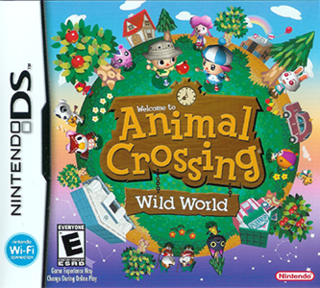
Animal Crossing: Wild World is a 2005 social simulation video game developed and published by Nintendo for the Nintendo DS handheld game console. It was released in Japan in November 2005, in North America and Australia in December 2005, and in Europe in March 2006. It is the second installment in the Animal Crossing series, and the sequel to Animal Crossing on the GameCube.

Super Mario 64 DS is a 2004 platform game developed and published by Nintendo for the Nintendo DS. It was a launch game for the DS. Super Mario 64 DS is a remake of the 1996 Nintendo 64 game Super Mario 64, with new graphics, characters, collectibles, a multiplayer mode, and several extra minigames. As with the original, the plot centers on rescuing Princess Peach from Bowser. Unlike the original, Yoshi is the first playable character, with Mario, Luigi, and Wario being unlockable characters in early phases of the game.
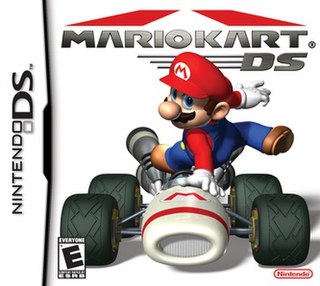
Mario Kart DS is a 2005 kart racing video game developed and published by Nintendo for the Nintendo DS handheld game console. It was released in November 2005 in North America, Europe, and Australia, and on December 8, 2005, in Japan. The game was re-released for the Wii U's Virtual Console in North America and PAL regions in April 2015 and in Japan in May 2016. The game is the fifth main entry in the Mario Kart series of video games, and the first to be playable via the Nintendo Wi-Fi Connection online service. Like other games in the series, Mario Kart DS features characters from the Mario series and pits them against each other as they race in karts on tracks based on locations in the Mario series.

Castlevania: Dawn of Sorrow is a 2005 action role-playing game developed and published by Konami. It is part of Konami's Castlevania video game series and the first Castlevania game released on the Nintendo DS. The game is the sequel to Castlevania: Aria of Sorrow and incorporates many elements from its predecessor. Dawn of Sorrow was commercially successful. It sold more than 15,000 units in its first week in Japan and 164,000 units in the United States during the three months after its initial release.

Mr. Driller Drill Spirits is a 2004 puzzle video game developed and published by Namco for the Nintendo DS. Controlling one of six characters, the player must make it to the bottom of each stage by destroying, colored formations of blocks while preventing their oxygen meter from depleting. Multiple different gamemodes are present, including a single-player campaign, a time-attack mode, and a competitive multiplayer mode. It is the sixth entry in the Mr. Driller series.

Meteos is a 2005 tile-matching video game developed by Q Entertainment and published by Bandai for the Nintendo DS. It was produced by Q Entertainment founder Tetsuya Mizuguchi and designed by Masahiro Sakurai. Meteos was inspired by the video game Missile Command (1980), the film The Matrix (1999) and the television series 24 (2001-2010).
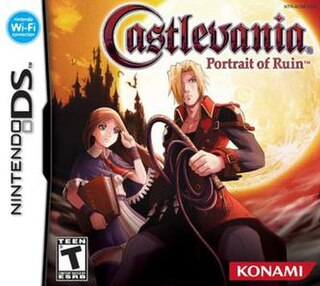
Castlevania: Portrait of Ruin is a 2006 action role-playing game developed and published by Konami. The game was released on November 16, 2006 in Japan, and in North America on December 5, 2006 for the Nintendo DS handheld game console. Portrait of Ruin is the first Castlevania to feature a cooperative multiplayer gameplay mode and the first handheld Castlevania to have English voice-overs, outside of its original Japanese release.

Bleach: The Blade of Fate is a 2D fighting game that features the cast of characters from the Bleach anime and manga. The game featured Nintendo's Wi-Fi Connection, which allowed players to connect and play against players all over the world. The game modes include story mode, arcade mode, VS mode, training mode, challenge mode, and survival mode, time attack mode and Urahara shop. The game's theme song is "Ichirin no Hana" by High and Mighty Color.

Elebits, known in PAL territories as Eledees (LEDs), is an action/first-person shooter game developed and published by Konami for the Wii. It was released as a launch title on December 2, 2006 in Japan, then December 12, 2006 in North America, May 4, 2007 in Europe, and May 17, 2007 in Australia.

Pokémon Battle Revolution is a turn-based strategy video game in the Pokémon series developed by Genius Sonority and published by The Pokémon Company and Nintendo. It was released for the Wii on December 14, 2006, in Japan; on June 25, 2007, in North America; on November 22, 2007, in Australia, and on December 7, 2007, in Europe. Along with being the first Wii incarnation of the Pokémon video game franchise, it is also the first Wii game to use the Nintendo Wi-Fi Connection in North America and Japan and the second Wii game to wirelessly interact with the Nintendo DS handheld.

Contra 4 is a 2D action game published by Konami Digital Entertainment in the United States and developed by WayForward Technologies. It is the eleventh overall installment of the Contra series, and was released in North America on November 13, 2007 for Nintendo DS. A mobile port was released six days later on November 19, 2007. A rerelease, called Contra 4: Redux, was released for Android in 2011.

Mario Kart Wii is a 2008 kart racing game developed and published by Nintendo for the Wii. It is the sixth installment in the Mario Kart series, and was released in April 2008. Like its previous installments, Mario Kart Wii incorporates playable characters from the Mario series, who participate in races on 32 different race tracks using specialized items to hinder opponents or gain advantages. The game features multiple single-player and multiplayer game modes including two- to four-person split screen. Online multiplayer was supported until the discontinuation of Nintendo Wi-Fi Connection in May 2014. Mario Kart Wii uses the Wii Remote's motion-controls to provide intuitive and conventional steering controls. Each copy of the game was bundled with the Wii Wheel accessory to augment this feature and mimic a steering wheel.
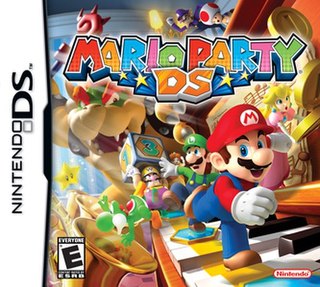
Mario Party DS is a 2007 party video game developed by Hudson Soft and published by Nintendo for the Nintendo DS. It is the second handheld game in the Mario Party series, as well as the last game in the series to be developed by Hudson Soft, as all subsequent titles have been developed by NDcube. The game was later released on the Virtual Console for the Wii U in April 2016.
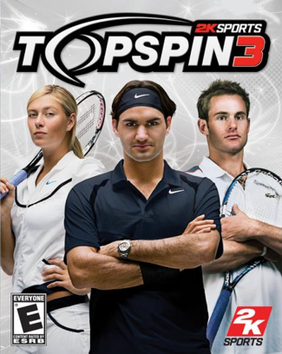
Top Spin 3 is the third title in the Top Spin series of video games. The game was developed by PAM Development and published by 2K. New game elements include real-time weather effects, more options of professional tennis players, an in-depth character creation tool and new unparalleled gameplay mechanics. It also features impressive advancements in an audio/visual sense with improved Dolby Digital surround sound and "Evolutionary" visuals. Top Spin 4 was released as a sequel about three years later.

Kingdom Hearts 358/2 Days is an action role-playing video game developed by h.a.n.d. and Square Enix in collaboration with Disney Interactive Studios for the Nintendo DS. It is the fifth installment in the Kingdom Hearts series, and takes place near the end of the first game in parallel to Kingdom Hearts: Chain of Memories, leading directly into the events of Kingdom Hearts II. The game was released worldwide in 2009. The story is told from the perspective of Roxas, and follows his daily life within Organization XIII and his relationship with fellow Organization member Axel; it also introduces a fourteenth member, Xion, who befriends them.

Spore Creatures is a 2008 science fiction adventure game developed by Griptonite Games and published by Electronic Arts. The game is a spin-off of Spore in which a player controls and evolves a creature of their creation to save another creature from the clutches of an alien who plans on dominating the galaxy.

Skate It is a skateboarding video game developed by EA Montreal, Exient Entertainment and EA Black Box for the Nintendo DS, Wii, and iOS. The game is a spin-off of 2007's Skate and was released in 2008.

Castlevania, known in Japan as Akumajō Dracula, is a 1986 platform game developed and published by Konami for the Family Computer Disk System. It was originally released in Japan in September 1986, before being ported to cartridge format and released in North America for the Nintendo Entertainment System (NES) in May 1987 and in Europe in 1988. It was also re-issued for the Family Computer in cartridge format in 1993. It is the first game in Konami's Castlevania video game series.



















